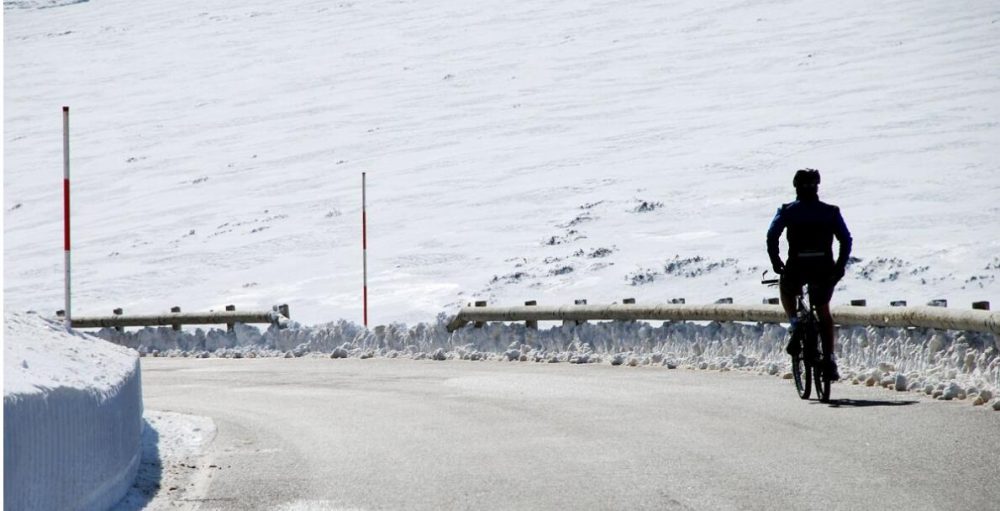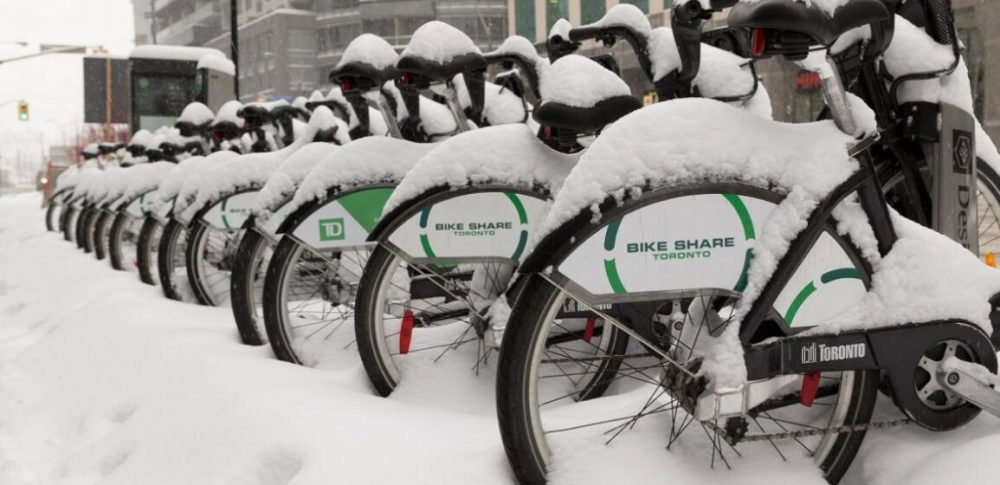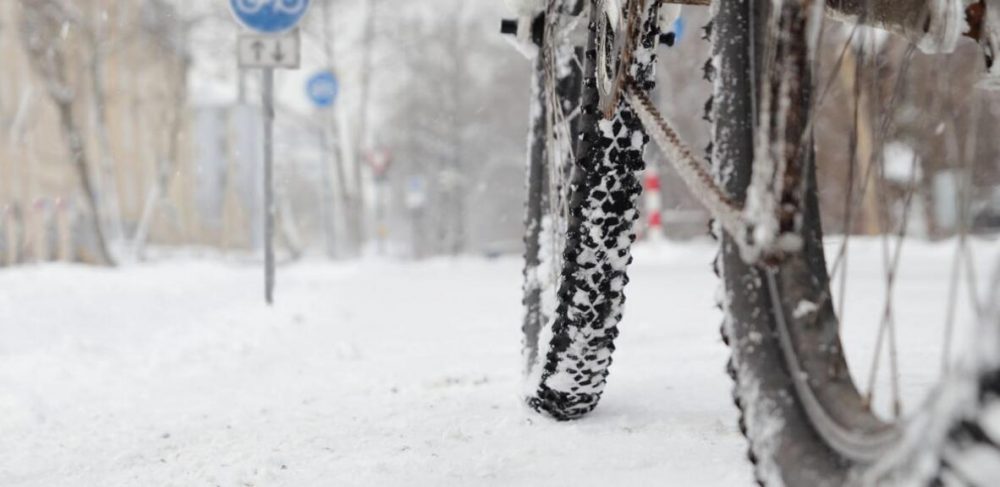Most of us are just ordinary folks who get this addiction to bicycles that simply will not live within the bounds of a summer.
Others just don’t want to spend the cash for a car and all the costs that come with motor vehicles.
Some of us have serious personal commitments to being car-free, other have temporary problems of liquidity, and others of us just like cycling way more than any rational person should.After the challenge of the first winter, icebiking takes on an air of normalcy, it becomes a practical and rational way to get out and enjoy the weather, and the trip.
Its an addiction. Handling a bike on ice requires more skill than summer riding, and plowing through snow is very tiring. The rewards are the beauty of the scenery, the quiet of the road on a frosty night, and the crunch of crisp snow under your tire. Making the first track!

Communting by bike in the winter
There is a big difference between going for a bike ride on a sunny Saturday afternoon and getting up each day at the crack of dawn and icebiking to work. This is where the diehard winter cyclists come alive. Even in the summer there is a big difference in going somewhere to ride your bike, and riding your bike to go somewhere. One is recreation, the other is transportation. This is not to say that winter commuting is not enjoyable.
The transportational icebiker is interested in reliability. Oddly enough, the bicycle is a serious contender for the reliability award. Not that it doesn’t require a fair bit of maintenance, but it does not freeze up in winter, never needs a jump start or a tow, and can be totally replaced for what most motorists pay for a minor fender repair. Anyone handy with modest tools can do almost all bike repair at home.
Choosing the right equipment
Winter commuters need specialized equipment that you might not need on your typical run “up the trail” or over the river in recreational icebiking.
Some of the obvious ones are below:
- A lock that exceeds the total weight savings of the lightest bike and the most brutal diet.
- Fenders.
- On-road repair kit and tools, patches etc.
- Bus fare stashed in bike bag (Having it seems to ward off having to use it).
- Then there are the not so obvious items:
- An odd collection of clothes that can be mixed and matched to provide protection down to ridiculous temperatures and still light enough so as avoid looking like the Michelin Man.This usually ends up being a combination of bicycle clothes and regular winter wear. It is not uncommon to wear shorts (bike or otherwise) into November due to the fact that you will sweat to death if you wear long tights underneath your rain pants till it gets down below freezing.
- Hard to find winter cycling tights. Some folks just wear regular pants, but this seems to make pedaling harder. Finding good winter tights is a problem, because bike gear producers still don’t “GET” winter cycling.
- The ever elusive winter cycling shoe. Warm, not “ventilated”, waterproof and light. No such animal exists in the bike world, but you can come close if you shop at sporting goods stores for light weight hiking boots. This is another area that the race-minded cycling industry just does not get.
- Bicycle Mirror, when you are all bundled up it is harder to turn your head to peek at traffic, a good mirror can help. Helmet or eye-glass mounted mirrors are very serviceable.

Bike parking
Depending on where you work you may or may not have adequate bike parking. Most cyclists would like to bring the bike indoors while at work. This is not always desirable or allowed because of the vast amounts of road grit (paid for by tax payers – distributed by sanding trucks) that your bike picks up in winter.
At the very least you have to bring in your battery. Its performance will suffer if left out there. Then depending on the crime element in your vicinity, you might have to strip the bike of valuable items, and lock it to something really solid.
Far better if you can negotiate somewhere to park a filthy bike, such as under a stair well or in a utility room.
An Alternative View: Bringing a snowy cold icebike into a warm area just lets it rust faster. Maybe it would be better left outside. Just bring in the battery.
Lights for the urban commute
Unless you want to carry your charger, you need batteries that will last at least the duration of “there and back”. It is nice to be able to go for a couple days before recharging. Its hard to buy too much battery capacity.
Second, you need a tail light of some sort. The little led blinkie thingies seem to be all the rage today. Do yourself a favor. Park your bike with blinkies blinking and walk back one block in the sort of environment you will be riding. If after this test you are still confident of these lights go ahead and use them. Better yet, use two of them. See our lights page.
When it starts snowing and those big flakes or blowing I like to add a strobe light that you can purchase in outdoor activity stores, or see here.
These create a ball of light as they flash against the falling snow. They do get attention. Attach them to your traffic side arm, not your bike.

Tactics and tips
Road Hazards Icebiking on the roadway in winter can be more hazardous than summer biking, but there are some good points too.
If you road-bike a lot, you may have noticed that where there are bike lanes motorists will feel free to pass you 6 inches off your elbow, but where there are no bike lanes (on a road of similar width) they will give you 3 feet of clearance. This is the bike lane induced squeeze factor. Those motorists are somehow convinced that the 6 micron-high strip of point somehow protects cyclists.
In the winter the bike lanes often are obscured. When this happens you will notice that the motorists act like there are no bike lanes and start sharing the road properly. In general, I find that motorists treat cyclists better in winter than in summer. I more frequently have to “take the lane” in winter due to snow plowed into bike lane. I seldom get any grief from motorists for this.
Watch it around stop signs. Air headed motorists are usually quite surprised to find that the darned thing doesn’t want to stop all that well and they will come sliding right through. Generally watch intersections very carefully in winter.Flats are also less frequent in the winter. There are fewer drunks riding around throwing bottles out of car windows, and more snow plows flinging road debris off of the roadway. In some parts, the only time of year the bike lanes get maintained is winter when they are plowed.
Traction
Just because a portion of the road is clear of snow does not mean it provides good traction. Often the wheel tracks get a glaze over them due to melting of ice and snow as the cars drive over it, followed by freezing again. This yields a thin layer of nearly invisible black ice.
The snow covered part of the roadway, or bike lane, can provide more traction. This is due to the presence of the snow. Snow crystals are rough enough to provide a fair degree of traction in this situation.
You will often hear a squeak on each power stroke as your rear wheel compresses the snow. That squeak is your assurance that the snow is providing good traction, in spite of slippery conditions below the snow. The slushy wet snow does not squeak like this, and that is your clue to look out for skids or slick ice under a layer of slush.
I occasionally prefer to ride in up to three inches of snow rather than go onto the seemingly bare roadway which is actually covered with black ice. After about three inches (depending on how wet it is) it gets to be too much work. However, I find I can get into my lower gears and push through 6 to 8 inches of fairly heavy snow easier than I can deal with that same 6 inches after it is compacted and rutted by cars on an otherwise unplowed road.
The hardpacked snow (white ice) can really be miserable and dangerous if it gets rutted and bumpy. However, once a sand-truck has passed by, this surface tends to supply a lot of traction, and even though you are riding on ice, the embedded sand and gravel eliminate the need for studded tires.
Wet ice or a road full of black ice or the need to travel sections of paths that are not sanded call out for studded bike tires. Short of the wet ice conditions, most snow is not all that slippery under your tires and normal tires may be quite serviceable. For commuting, I prefer an inverted tread tire such as the Continental Town and Country tire. After 4 years of commuting on my first set, I have come to appreciate that some things are worth paying more for.
If you are interested in motorized bike and want to know more, you could browse previous articles or visit our Official Website, also choose to leave your message below. If you are interested in electric bike, you can contact us. https://hotebike.en.alibaba.com/
Read more bike tips:
E-bike Market Trends, Analysis and Challenges 2021
Do you need a license to ride an electric bike
Summer Weather Tips for Your Electric Bike Battery
7 Reasons You Should Go For Mountain Bike Disc Brakes
 Shuangye ebike
Shuangye ebike
